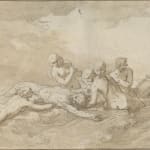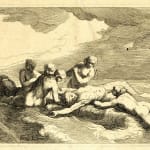Open a larger version of the following image in a popup:


Frederik Bloemaert after Abraham Bloemaert, Leander carried by the Nereids.
engraving on paper; British Museum inv. no. 1872,1012.1453.
Abraham Bloemaert (Gorinchem 1566 - 1651 Utrecht)
Leander carried away by the Nereids
pen and brown ink, brush and wash and white bodycolour over black chalk
114 x 188 mm
Abraham Bloemaert was born in Gorinchem in 1566. His father Cornelis - a sculptor and an architect - moved the family to Utrecht in 1575, where the young Abraham was...
Abraham Bloemaert was born in Gorinchem in 1566. His father Cornelis - a sculptor and an architect - moved the family to Utrecht in 1575, where the young Abraham was apprenticed to Gerrit Splinter and, later on, Joos de Beer. Between ca. 1581 and 1585 he studied in Paris under different masters, including with Hieronymus Francken in Fontaineblau. In 1585 he returned to Utrecht. When his father was appointed stadsbouwmeester (city architect) in Amsterdam in 1591, he followed him there, setting up a workshop in the church of the Order of Poor Ladies. In 1592 he married Judith van Schonenburch. After his father's death in 1593 he went back to Utrecht, where he lived and worked until he died in 1651 at the age of 84.
In 1594 Bloemaert became a member of the local saddlemaker's guild, as the Utrecht painters did not yet have a Guild of St Luke of their own. After the death of his first wife in 1599, he married Gerarda de Roy one year later. The couple had at least eight children, four of which - Hendrick, Cornelis II, Adriaen and Frederick - all became successful artists in their own right. In 1611 he - along with Joachim Wtewael and Paulus Moreelse - was one of the founding members of the Utrecht Guild of St Luke. In addition to his four sons, he trained dozens of other artists, including many of the leading Utrecht caravaggists such as Hendrick ter Brugghen, Gerard van Honthorst and Matthias Stom.
Abraham Bloemaert was a very versatile artist, who depicted not only biblical and mythological themes but also produced genre scenes, landscapes and even some still life paintings. He was a prolific draughtsman and continued working until well into his eighties. Stylistically he was somewhat influenced by Frans Floris (who had taught many of his own teachers) and other Italianizing painters, although he never actually visited Italy. He was one of the major exponents of Northern Mannerism, before coming somewhat under the influence of caravaggism in the 1620's. His later work was more classicist in style.
The present drawing is a beautiful testament to Bloemaert's great skills as a draughtsman. It depicts Leander being carried away by the Nereids. Leander was the lover of Hero, a priestess of Aphrodite who dwelt in a tower (which can be seen to the right in the drawing) in Sestos, on the European side of the Hellespont. Every night, Leander - who lived across the strait in Abydos - crossed the sea to visit his beloved Hero, but one night he was drowned in a storm and the sea nymphs carried him in their arms. Overcome by grief, Hero joined him in his tragic fate.
The drawing was engraved by Bloemaert's son Frederick (seel ill.); the engraving is signed 'A Bloemaert inven:', firmly establishing the authorship of our drawing.
Provenance
D. Muilman, his sale, Amsterdam, J. de Bosch/Yver, 29 March 1773, Kunstboek C, no. 217, acquired by Aert Schouman;
By whom sold prior to his estate sale in 1792;
Belgian private collection;
Sale Amsterdam, Sotheby's/Mak van Waay, 29 October 1979, lot 215 (ill.);
Private collection, Brussels.
Literature
J. Bolten, Abraham Bloemaert (c. 1565 - 1651). The Drawings, Leiden, 2007, vol. I, no. 530 & vol. II, p. 244 (ill.)




